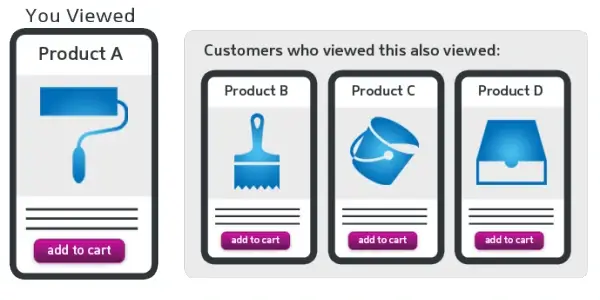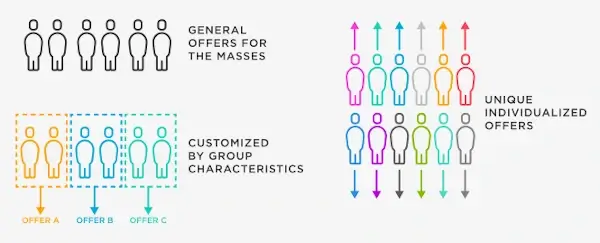
Big data and its capabilities are becoming more prevalent across various sectors and market segments. It gives businesses and entrepreneurs access to previously unheard-of potential for process optimization, service quality improvements, and conversion rate growth. Big data was once a cutting-edge technology for extremely complicated work environments, but nowadays, it's getting increasingly popular in commercial sectors.
Big data is large, varied information sets that are expanding exponentially. Ecommerce may use it to make better business decisions and improve performance, goods, and operational procedures. Additionally, it facilitates finding valuable insights and assists in studying client behavior.
Many eCommerce executives still have trouble using data science, even though it can streamline multiple processes in the company, including operational procedures, budgeting, and marketing. Read on to get a deeper understanding of big data's key benefits to the eCommerce sector.
What is Big Data?
Big Data is usually characterized by the volume of data, the velocity at which it is generated and gathered, and the variety or depth of the data points being considered (the three V's of big data).

- Volume refers to the original size and volume of data collected. It ought to be significant enough for the data to qualify as big. It is a relative measurement, though, and depends on processing speed. Big data ranges from a few megabytes to hundreds of petabytes.
- Velocity is the speed at which data is produced and transferred. A business that uses big data will have a sizable and continuous flow of data from networks, cellphones, social media, Internet of Things (IoT) devices, and other sources. This information needs to be processed, transferred, and analyzed quickly.
- Variety refers to the categories the data belong to, from structured, quantitative data to unstructured text documents, emails, movies, and audio.
Big data encompasses all conceivable business activities and includes structured and unstructured information. Information that the business has previously managed in databases and spreadsheets is referred to as structured data and is typically quantitative. Unorganized information that can't fit into a preset model is referred to as unstructured data. It usually contains information from social media, which aids organizations in learning more about the customers' needs.
Big data may be obtained through polls, online orders, electronic check-ins, personal devices and applications, comments on social media and websites, and other open sources. Smart devices have sensors and other inputs, enabling data collection across various conditions and scenarios.
Big data is most frequently kept in computer databases and examined with software made to deal with enormous, complicated data volumes. Many companies manage their data locations through CRM systems. It's possible to make management easier by involving additional tools, such as RingCentral Salesforce integration. Software as a service (SaaS) businesses focusing on handling this complex data are widespread nowadays. The most popular big data management tools are Apache Hadoop, Apache Storm, Apache Cassandra, Cloudera, RapidMiner, and Lumify.
More data allows precise analysis, benefiting the business — accurate analytical output results in better judgments. And better decisions lead to increased efficiency, lower costs, and fewer hazards for a business.
Benefits Big Data Brings to Ecommerce
Compared to simple analytics analysis, big data implies a much bigger volume of information, giving a more comprehensive picture of business processes. To maximize big data benefits, it should be adopted carefully and gradually. Here are some ways big data can be helpful for your online store.
Understand Your Customers Better
Analyzing client behavior, demands, and experiences are now possible with big data technology. Businesses may determine and forecast which solutions will better meet customers' needs.
Big data allows you to analyze search results and adjust your marketing approach accordingly. For instance, you may enhance SEO and marketing strategies based on trending search inquiries.
Another example of how you can apply received knowledge about the customers is cross-selling and up-selling. For instance, you can introduce the "customer who viewed this also viewed" tab on your website, displaying other goods bought or considered with the product of interest by other users.

Provide a Better Shopping Experience
E-commerce websites can track statistics like the mean time between a visit to the homepage and purchase, the average number of clicks per page, the number of products users add to their shopping carts before checking out, and so forth.
Referral or email marketing programs might also offer insightful information. Analyzing data from business referrals can further enrich the understanding of consumer behavior, enhancing targeted marketing strategies. Businesses can research customers' demographics, interests, gender, age, and occupations.
This data enables you to reduce the time to purchase, avoid cart abandonment, and adapt to new trends. Predictive analytics also helps with stock management during seasonal and economic swings. It allows you to keep products available and quickly deliver them.
Collecting past data can be crucial for your user experience. Measuring website availability and page load speed and collecting the data from past seasonal peaks can prepare you for heavier traffic for upcoming peaks. Updating your hosting plan accordingly can help reduce website downtime and the annoying slow page loading.
The entire body of gathered data may also be used to find potential issues with customer service. Understanding what does not function properly permits modification and future customer service improvements. Additionally, reports and training materials for customer support agents may be created using the gathered information.
Reduce Costs for Your Team
Another advantage big data offers to e-commerce companies is the reduction of operational costs. Big data tools enable improvements in every area of operational strategy, from supply chains and marketing to customer experiences. As a result of these developments, budgeting undergoes significant modifications. This enables cost savings per team and overall operational approach optimization.
Provide Better Personalization
Ecommerce companies may group their customers based on gender, region, and social media activity. This information may be used for the following improvements:
- To personalize web pages based on search and purchase history;
- Provide the most pertinent material to new users who behave similarly to current customers;
- Introduce new products targeted at a specific consumer demographic;
- Create and send emails with customized offers.

Offer More Secure Online Payment Processes
Online payment operations are becoming more secure thanks to big data analytics. Companies utilize this information to identify financial frauds and guarantee secure payment on their websites since big data algorithms efficiently evaluate enormous amounts of data.
For instance, PayPal uses massive data sources to power machine learning techniques. Many e-commerce stores monitor their checkout transactions to prevent unwanted interruptions and fraud. Big data may also be utilized to see which payment options are most effective and preferred by clients.
Make More Strategic Business Decisions
E-commerce executives may use big data and real-time analytics to make better strategic decisions. For instance, eCommerce executives can find out which clients have the highest long-term value and spend more money recruiting, targeting, and retaining them. Using the analytics provided by big data resources, eCommerce companies can make budgeting decisions more strategic and logical.
Optimize Pricing
Different analytical methods, such as market segmentation, competitive analysis, or targeting strategy, can be used to establish the appropriate pricing. These strategies must rely on verifiable data to be effective and provide more financial gain. The likelihood of setting the correct pricing increases with the size of the data pool.
Big data analysis tools pull pricing-relevant information from many consumer touchpoints and other sources to determine the price that provides good bargains for customers while keeping a high profit. They do these calculations instantly based on predetermined criteria and algorithms, which aids e-store operators in making more calculated, strategic price decisions.
Dynamic pricing is another strategy that can be implemented using big data. E-retailers may increase sales by providing items at a cost that varies from customer to customer or changes hour-by-hour based on a set of criteria.
Different corporate objectives may be attained through dynamic pricing. It's not always about taking advantage of consumer demand or pushing as many products as possible. Some businesses may employ this strategy to gain a return on their investment, get rid of surplus inventory, attract new customers, or win them from rivals.
Big Data Adoption Issues

Although the prospects are bright, leveraging big data in eCommerce may not be easy. Merchants can face multiple issues while implementing big data.
- Inconsistency. The issue with data in any company is that it is always stored in many locations and in various forms. Even gathering an insignificant amount of data can become a problem if you need to search for it through different folders and transform it into a unified format.
- Lack of coordination. Data analytics frequently come down to ill-focused activities since there is no central point of accountability. Such initiatives result in omitted stages and incorrect judgments. No matter how clever a data governance policy is, it will fail if no one is coordinating it.
Due to the difficulty in implementing big data, the organization receives inaccurate results from algorithms that are given inaccurate data and faces more security and privacy threats. Additionally, it wastes money since data teams handle data with little commercial value.
- Solving the wrong problem. Launching a big data program with an ambiguous strategic goal is a poor idea, as you receive a ton of useless information that your data team spends time producing. Even a clearly stated purpose not connected to any potential commercial outcome would be futile.
Answering the questions about what to measure to determine value will be easier if you have a clear and achievable business goal. People often opt to utilize metrics or conventional performance indicators since they are easier to follow, which leads to many initiatives failing.
Final Words
Big data has completely revolutionized the eCommerce sector. Customers gain from the individualized, real-time experience, while Big Data aids eCommerce businesses in increasing profits. Customers may easily explore and purchase the goods they are interested in, while business owners generate more money. Big data seeks to put the customers in front of the relevant goods at the right moment.


 Copyright 2000-2026, WebSitePulse. All rights reserved.
Copyright 2000-2026, WebSitePulse. All rights reserved.